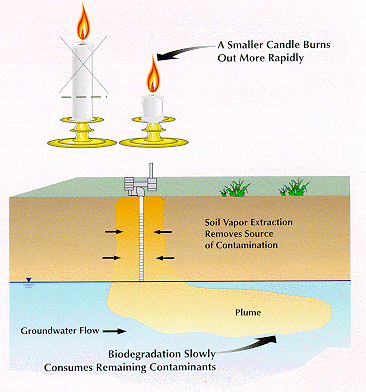
This brochure was developed through a partnership
among the U.S. EPA, Air Force, Army, Navy, and Coast
Guard.
What is natural attenuation?
When petroleum products such as gasoline, jet fuel or diesel fuel are spilled or leak into soil or groundwater, several natural processes begin to destroy or alter the chemical components of the fuel. These processes include adsorption on soil particles, biodegradation, and dilution and dispersion in groundwater (see Components of Natural Attenuation on the next page).
"Intrinsic" and "passive" remediation are other terms that have been used to describe the combined effect of these processes. Dr. John Wilson of the EPA compares natural attenuation in groundwater to a lighted candle. The source of the flame is the wax of the candle, just as the source of the groundwater contamination is the more concentrated petroleum trapped in the soil. The flame appears steady because the wax is destroyed in the flame as fast as it is removed from the candle. In the same way, the groundwater plume will reach "steady state" at some distance from the source when natural bacteria are able to destroy contaminants as they enter the groundwater from the soil. Eventually, the candle is consumed by the flame just as contaminants in the soil and groundwater are consumed by natural bacteria.

|
|
How is natural attenuation different from the "do nothing" approach?
Natural attenuation is sometimes mislabeled as the "do nothing" or "walk away" approach to site cleanup. The truth is that natural attenuation is a proactive approach that focuses on the verification and monitoring of natural remediation processes rather than relying totally on "engineered" processes.
Before natural attenuation should be proposed for any site, significant soil and groundwater data must be collected and evaluated to document that natural attenuation is occurring and to estimate the effectiveness of natural processes in reducing contaminant concentrations over time. If natural attenuation is selected as the preferred site remedy, the party responsible for site cleanup must commit to long-term monitoring to verify that the contaminants pose no risk to human health or the environment, and that natural processes are reducing contaminant levels and risk as predicted.
|
Biodegradation - At many sites, natural bacteria in the soil and groundwater will use petroleum compounds as their primary source of energy or food. Although the rate at which bacteria destroy petroleum products will vary from site to site, natural biodegradation has now been documented at many contaminated sites around the world. Dilution/Dispersion - As contaminants mix with soil and groundwater over time, their concentrations are reduced; however, these processes do not destroy contaminants. Adsorption - Many contaminants are prevented from entering the groundwater and migrating off the site because they are adsorbed onto soil particles. |
How can you tell if natural attenuation may work at a site?
Experts in the science of natural attenuation have identified several indicators or lines of evidence that can be used to prove that natural processes are reducing contaminant concentrations. One or more of the following lines of evidence are normally required to document natural attenuation:
Historical trends indicating a decrease in contaminant concentrations over time and a plume that is stable or retreating. A stable or retreating plume indicates that biodegradation is removing dissolved contaminants from the groundwater at an equal or greater rate than the source is adding them to the plume.
Chemical indicators. Biodegradation of contaminants is directly related to changes in groundwater chemistry such as the biological consumption of natural levels of oxygen, nitrate, and sulfate and the creation of byproducts such as dissolved iron (II), manganese (II), and methane. These geochemical indicators can be used to estimate the site specific potential for contaminants to be destroyed by biodegradation.
Laboratory "microcosm" studies. These studies can be used to simulate aquifer conditions and to demonstrate that native bacteria can biodegrade contaminants of concern under controlled conditions, where their rate of destruction can be measured more directly. Generally, this technique is only recommended when one of the first two lines of evidence is inconclusive.
The Air Force Center for Environmental Excellence has developed a comprehensive protocol (Technical Protocol for Implementing Intrinsic Remediation with Long-Term Monitoring for Natural Attenuation of Fuel Contamination Dissolved in Groundwater) that describes how this evidence can be collected during site investigation activities.
Do federal, state, and local regulations allow natural attenuation as an option for petroleum site remediation?
Although natural attenuation is not a default option or a "presumptive remedy," it is recognized by the EPA as a viable method of remediation for soil and groundwater that can be evaluated and compared to other methods of achieving site remediation as a part of the remedy selection process. The selection of natural attenuation as a component of any site remedy should be based on its ability to achieve remediation goals in a reasonable timeframe and to be protective of human health and the environment. Natural attenuation, just as any remedy, must comply with state groundwater use classification and cleanup standards. EPA recognition of natural attenuation extends to sites regulated under the Comprehensive Environmental Response, Compensation, and Liability Act (CERCLA); the Resource Conservation and Recovery Act (RCRA); and underground storage tank (UST) regulations. In addition to EPA acceptance, many state UST programs now accept natural attenuation as a valid approach for remediating petroleum-contaminated sites.
|
Lt Col Ross Miller, USAF |
Can natural attenuation achieve site cleanup goals?
Natural attenuation can be an effective means of achieving cleanup goals, particularly when these goals are based on site specific risk reduction. For example, if petroleum contamination is found in industrial areas, direct human contact with contaminated soil or groundwater is generally rare and for only a short duration. The shallow groundwater in these areas is seldom suitable or required for drinking water. Human health can be protected if groundwater use and excavation activities can be controlled until cleanup goals are reached. Engineered remediation methods may achieve cleanup goals in less time. The additional cost of engineered remediation must be balanced with the benefits of restoring groundwater to beneficial use and more rapid site closure.

What sites are best suited for natural attenuation?
Petroleum sites that are located on federal facilities may be good candidates for remediation using natural attenuation. These sites should meet one or more of the following criteria:
The site is located in an area with little risk to human health or the environment from direct and repeated contact with contaminated soil or groundwater.
At active federal facilities, the government is in a position to control or specify future land and groundwater use to ensure that human health is not impacted. Even at facilities that are scheduled for closure and public redevelopment, deed restrictions and zoning ordinances can be specified to prevent contact with contamination.
The contaminated soil and groundwater are located an adequate distance from potential receptors.
Some form of active source area remediation, such as free product recovery, bioventing, or soil vapor extraction, has removed the long-term source of groundwater contamination.
What are some of the potential advantages and limitations of natural attenuation?
Potential Advantages
| Less generation or transfer of wastes. | |
| Less intrusive and disruptive than engineered methods. | |
| Can be combined with active remedial measures or used to remediate a portion of the site. | |
| Remediation costs may be lower than with active remediation. |
Potential Limitations
| May require more time to achieve cleanup goals. | |
| Requires a commitment to long-term monitoring and associated costs. On some sites, long-term monitoring costs can be excessive. | |
| If natural attenuation rates are too slow, the plume could continue to migrate. | |
| Land and groundwater use controls are often required. |
Can natural attenuation processes be enhanced to speed up the cleanup process?
At some sites, natural attenuation alone may be unable to achieve cleanup goals within a reasonable timeframe. At these sites, a combination of natural and active remediation will often result in more rapid risk reduction for little additional cost. Two forms of active remediation are frequently used at petroleum contaminated sites: source reduction and oxygen addition to the plume.
Again, the candle analogy is useful to illustrate how active and natural remediation can be combined. If the top half of the candle (the source) is cut off and removed, the flame (plume) will exist for only a fraction of the original time. Bioventing, soil vapor extraction, and free product removal are all methods of reducing the source of contamination. The rate at which the candle bums can be enhanced by increasing the supply of oxygen. The addition of oxygen to the groundwater plume using biosparging or oxygen release compounds will enhance the natural rates of biodegradation and speed up the plume's destruction.

Is natural attenuation commonly used at federal facilities as a remedy for petroleum-contaminated sites?
Remediation project managers are now recognizing the positive effects of natural attenuation and documenting its role in the remediation process. Many federal agencies, including the EPA, now recognize natural attenuation as a potential remediation option for petroleum-contaminated sites.
What if natural attenuation does not work at a site?
As with any remedy, if monitoring results indicate inadequate progress, it will be necessary to reevaluate the remedial action plan. Under these circumstances, the remediation project manager would consider implementing an engineered approach for all or part of the plume.
This brochure was developed through a partnership among the U.S. EPA, Air Force, Army, Navy, and Coast Guard. If you would like additional information about natural attenuation and its application at federal facilities, you may fax your request to the National Center fair Environmental Publications and Information at (513) 489-8695 or contact the following agency home pages on the Internet:
EPA - http://www.epa.gov
Air Force -
http://www.afcee.brooks.af.mil
Army -
http:aec-www.apgea.army.mil:8080
Navy -
http://www.nfesc.navy.mil
Coast Guard -
http://www.dot.gov/dotinfo/uscg

| Back to Top | FFRRO Home | EPA Home | FFRRO Frequently Asked Questions | FFRRO Innovative Technologies |